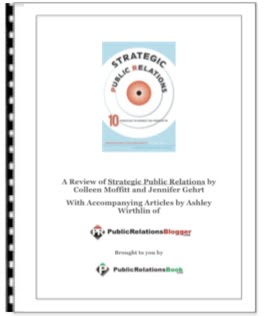________________________________________________________________________
 Media relations is a great profession.
Media relations is a great profession.
On good days, I earn my living speaking to and learning from knowledgeable experts who ask for help in raising the profile of their cause through the media. In the past few years, I’ve worked with billionaire philanthropists, a Pulitzer Prize-winning scientist and a world famous actor. Mostly, though, I work with unknown but equally impressive professionals regarded as experts in their fields.
When I speak to them, I’m always listening for “the story.” Some of the time, the story is immediately apparent. But the most gratifying moments come when a story seemingly devoid of news value suddenly leaps out and surprises me.
Two years ago, for example, I was doing media work for a Washington DC-based environmental organization. Scientists from the group would regularly contact me regarding their latest field work, hoping I could convince a reporter to shine a spotlight on their project.
One day I met with a charismatic field biologist to discuss his project while sipping coffee in a depressing restaurant. As he told me about his project, I quietly became more convinced that he didn’t have much of a story. I felt bad, but suspected no reporter would bite.
The West African forest elephant, he told me, was in trouble. The problem was largely one of capacity - no West Africans had been formally trained in protecting the 7,700-pound mammals, which were being killed by the farmers who feared them.
To help correct the problem, he said, they had established a program three years earlier to train six West Africans to conserve the majestic beasts. In a month, they would end their training and begin working to protect the animals full-time.
That’s when the idea hit.
I asked the scientist if we could call the group the first-ever graduating class from "Elephant University." When he agreed, I knew we were in business.
I drafted an e-mail with a few highlights to a reporter I had recently met from The Wall Street Journal. The story pitch suggested that this story was the perfect fit for the quirky daily front-page “Column Four” feature. The reporter quickly wrote back. He agreed.
Two weeks later, the reporter was off to Accra, Ghana to report the story firsthand. When the story ran on November 27, 2002, the words “Elephant University” - the ones we had happily stumbled upon over coffee - were emblazoned on the front-page.
This story worked because we didn’t pitch it “head on.” Remember - the heart of this story was that West African scientists were receiving training - not exactly front-page material. But by giving the reporter an unusual hook, he was able to convince his editors that the story deserved to be told.
If you’re speaking to an expert to assess a story’s newsworthiness and it doesn’t seem immediately obvious to you, keep talking. If they say something interesting, stop them. Ask them to slow it down and provide more detail. Paraphrase their response into something resembling a headline by asking, “Would it be correct to say it this way?” Finally, look for the nuggets. Ancillary parts of the story often jump out and become your lead.
Brad Phillips is the founder and president of Phillips Media Relations. He was formerly a journalist for ABC News and CNN, and also headed the media relations department for the second largest environmental group in the world.
Article Source.
Tags: writing tips, media relations, PR story, front page
Media Relations Tips for Getting Your PR Story on the Front Page
________________________________________
 Media relations is a great profession.
Media relations is a great profession.On good days, I earn my living speaking to and learning from knowledgeable experts who ask for help in raising the profile of their cause through the media. In the past few years, I’ve worked with billionaire philanthropists, a Pulitzer Prize-winning scientist and a world famous actor. Mostly, though, I work with unknown but equally impressive professionals regarded as experts in their fields.
When I speak to them, I’m always listening for “the story.” Some of the time, the story is immediately apparent. But the most gratifying moments come when a story seemingly devoid of news value suddenly leaps out and surprises me.
Two years ago, for example, I was doing media work for a Washington DC-based environmental organization. Scientists from the group would regularly contact me regarding their latest field work, hoping I could convince a reporter to shine a spotlight on their project.
One day I met with a charismatic field biologist to discuss his project while sipping coffee in a depressing restaurant. As he told me about his project, I quietly became more convinced that he didn’t have much of a story. I felt bad, but suspected no reporter would bite.
The West African forest elephant, he told me, was in trouble. The problem was largely one of capacity - no West Africans had been formally trained in protecting the 7,700-pound mammals, which were being killed by the farmers who feared them.
To help correct the problem, he said, they had established a program three years earlier to train six West Africans to conserve the majestic beasts. In a month, they would end their training and begin working to protect the animals full-time.
That’s when the idea hit.
I asked the scientist if we could call the group the first-ever graduating class from "Elephant University." When he agreed, I knew we were in business.
I drafted an e-mail with a few highlights to a reporter I had recently met from The Wall Street Journal. The story pitch suggested that this story was the perfect fit for the quirky daily front-page “Column Four” feature. The reporter quickly wrote back. He agreed.
Two weeks later, the reporter was off to Accra, Ghana to report the story firsthand. When the story ran on November 27, 2002, the words “Elephant University” - the ones we had happily stumbled upon over coffee - were emblazoned on the front-page.
This story worked because we didn’t pitch it “head on.” Remember - the heart of this story was that West African scientists were receiving training - not exactly front-page material. But by giving the reporter an unusual hook, he was able to convince his editors that the story deserved to be told.
If you’re speaking to an expert to assess a story’s newsworthiness and it doesn’t seem immediately obvious to you, keep talking. If they say something interesting, stop them. Ask them to slow it down and provide more detail. Paraphrase their response into something resembling a headline by asking, “Would it be correct to say it this way?” Finally, look for the nuggets. Ancillary parts of the story often jump out and become your lead.
Brad Phillips is the founder and president of Phillips Media Relations. He was formerly a journalist for ABC News and CNN, and also headed the media relations department for the second largest environmental group in the world.
Article Source.
Tags: writing tips, media relations, PR story, front page
Popular choices
- Non Gamstop Casino
- Mejores Salas De Póker
- Casino Non Aams
- Non Gamstop Casinos
- Siti Casino Online Non Aams
- Migliori Siti Casino Online
- UK Online Casinos Not On Gamstop
- Non Gamstop Casino Sites UK
- Non Gamstop Casino Sites UK
- UK Casino Not On Gamstop
- Casinos Not On Gamstop
- Online Casino
- オンラインカジノ
- UK Casino Not On Gamstop
- UK Casino Not On Gamstop
- Reputable Non Gamstop Casinos
- Casinos Not On Gamstop
- Best Non Gamstop Casinos
- Non Gamstop Casino
- Casinos Not On Gamstop
- Slots Not On Gamstop
- Non Gamstop Casino
- Casino Non Aams
- Casinos Not On Gamstop
- Betting Sites Not On Gamstop
- Casino Online Italia
- Casino En Ligne
- Casino En Ligne Belgique
- KYC 인증 없는 카지노
- Sites De Paris Sportif Fiables
Subscribe to:
Post Comments (Atom)






Comments (0)
Post a Comment